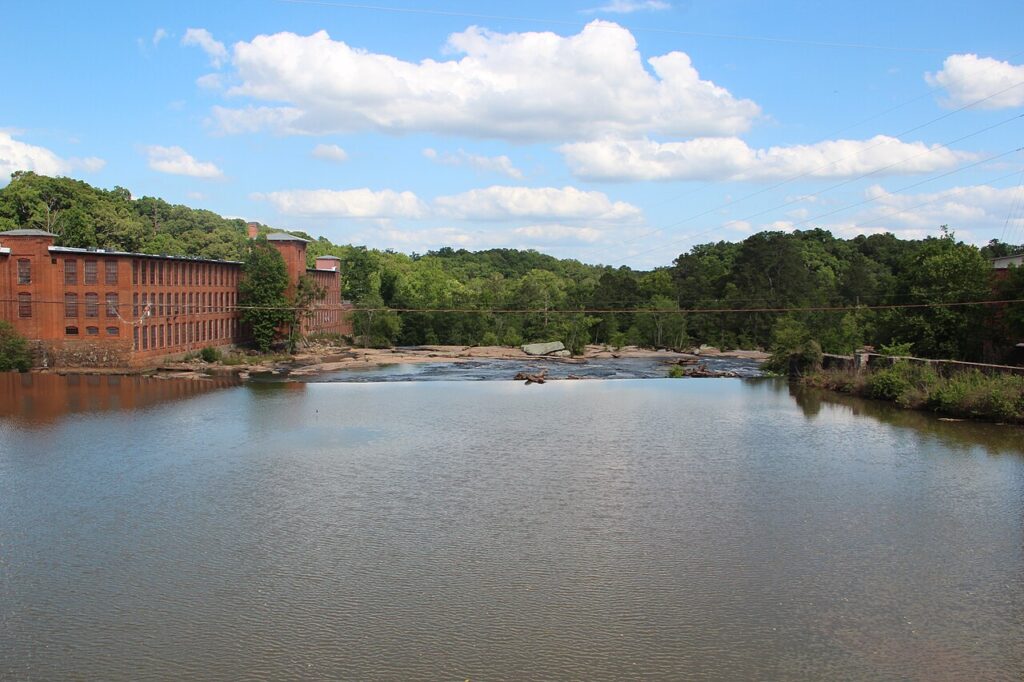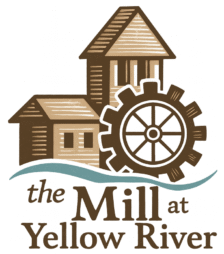The Mill at Yellow River
For over a century, the hum of cotton spindles echoed along the Yellow River in Porterdale, Georgia. Today, The Mill at Yellow River stands as both a memory and a monument — a story of work, water, and rebirth.

History of The Mill at Yellow River
The story of The Mill at Yellow River begins in the early 1800s along the Yellow River in what would become Porterdale, Georgia.
The river drops nearly 70 feet in less than a mile — a perfect location for harnessing waterpower.
Around 1830 to 1835, a small water-powered factory called Cedar Shoals Manufacturing Company was established by Noel (Noah) Phillips, using the river to drive textile machinery.
The community that formed around the mill was originally known as Cedar Shoals.
During the 1870s, local entrepreneur Oliver S. Porter purchased the mills and surrounding property.
Porter expanded production, built additional worker housing, and helped establish schools and churches for the growing population.
The town that developed around his operation was renamed Porterdale in his honor.
In 1890, the Porterdale Mill Company was organized, and the town became a hub of cotton manufacturing.
In 1899, the Bibb Manufacturing Company, one of Georgia’s largest textile corporations, bought the mill complex and began a massive expansion.
Bibb constructed the impressive north mill, stretching roughly 800 feet along the Yellow River with a distinctive brick tower that still defines the skyline.
Over the next two decades, Bibb Manufacturing added two more large mills — Osprey Mill (built 1916) and Welaunee Mill (around 1920).
Together, these mills formed one of the largest textile operations in the southeastern United States.
Bibb also built hundreds of tidy mill village homes, churches, schools, and recreational facilities, creating a self-contained company town.
Life in Porterdale revolved around the mill whistle — shifts, church bells, and social life all followed the rhythms of the factory.
By the 1930s and 1940s, Porterdale produced enormous quantities of cotton cordage and rope.
During World War II, the mill’s rope was used extensively by the U.S. Navy, and Porterdale was known nationwide for its production.
After the war, mechanization and foreign competition slowly began to erode the American textile industry.
Bibb continued to operate in Porterdale through the 1950s and 1960s, but production gradually declined.
In 1964, Bibb sold many of the company-owned houses to employees and residents, ending the classic “mill village” era.
By the 1970s, the main manufacturing operations had closed, and the once-busy buildings sat largely empty.
For decades, the massive brick structures stood as silent reminders of Georgia’s industrial past.
In the early 2000s, preservationists and developers recognized the site’s architectural and historical importance.
The Porterdale Mill Lofts project began, restoring the red-brick buildings into residential lofts and commercial space.
The redevelopment maintained the historic exteriors while giving new life to the interiors.
The former mill also briefly operated as an event and wedding venue known as The Mill at Yellow River, hosting celebrations within the restored industrial space.
The complex and surrounding mill village were listed on the National Register of Historic Places in 2001 as part of the Porterdale Historic District.
Today, the mill buildings, river dam, and worker cottages still reflect the character of an early-20th-century Georgia mill town.
Though the original factory machinery is gone, the site remains one of the best-preserved textile complexes in the Southeast.
The Mill at Yellow River stands as a symbol of industry, community, and rebirth — from water-powered beginnings to modern restoration along the banks of the Yellow River.
